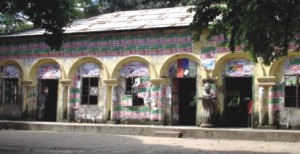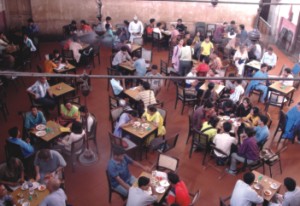|
Heritage
The Twin Living Legends
Shraman Jha
It is not everyday that one sits down to make comparisons. But when you are faced with two redoubtable institutions each so much like the other, and also so much unlike the other, that the thoughts need to be put down. Indeed, I was particularly fortunate to have visited nay, 'experienced' is a more appropriate word two legendary canteens, one in Dhaka and the other in Kolkata. Being located in the academic world, they have both been a part of folklore and have had tales spun around them, each not only having been a witness to history, but also having been a shaper of it.
The contrast could not have been starker, even if trivial: Modhu's canteen serves only tea, and no coffee and has retained a modest menu, unchanged over the years. The Kolkata coffee house has an exhaustive, colonial menu: but yes, you guessed it right, it serves no tea!
 |
A busy day at Modhu's Canteen |
My tryst with Modhu's was serendipitous. An enthusiastic friend thought he'd take me along to his adda. The experience including the conversation with the current owner Arun gave me goose pimples. Arunda began from the very beginning, when in 1921, his grandfather, Mr Adityo Chandra Dey of Bikrampur set up a canteen. Five years later, Adityo's son Modhusudan took charge while still a school student.
And there began the saga of one of the most enduring legends of Dhaka University: Modhu da's (as he was affectionately known) canteen, Modhu's canteen. As his popularity grew within the student and teacher fraternity, the canteen became a centre of political activism. He also took on a father-figure role at the university, and helped students who were short on cash. " Dhaka University students are my life" was his refrain.
The historic events of 1947, 1952, 1969, 1970 and 1971 all had action at Modhu's. At the peak of the Liberation war, Modhu and his canteen were under constant watch and he was interrogated often. However, he remained steadfast and did not breathe a word on the nationalist activities going on his canteen. But it was the night of March 26th, 1971 when his household was raided and the family tortured to death. Arun, a small child then, was a witness to this. The canteen has since remained in his father's name, to be used by the family, but not saleable.
 |
| The postered exterior of Modhu's Canteen |
In the midst of all this, much has remained the same, the menu for one! Shinghara, Samucha, Alur chop, Bread & Butter and Misti. No rice, no parota, no other "fast food". "We are not a commercial eating house" avers Arunda. "We are an institute for politics." He glows with pride as he talks on his special menu: shinghara with ghee. "Sheikh Mujib told my father that he thought of the Shinghara while being incarcerated".
The tradition of the tables being divided between the party in power and the opposition continues. "And I will continue the traditions of the canteen that Modhuda nurtured", comments Arunda. When you see the animated discussion along the two sets of tables, you know that nothing is going to change in a hurry.
Jumping cities, we shift our focus on The Coffee House, Kolkata. Not for nothing has the Manna Dey song "Coffee House" attained a must-be-sung status at every get together. The first thing which hits you as you walk up through the heavily postered stairway all political, not the filmi kind- is the buzz of gossip or discussion. Animated. Persistent. But never loud. Reach the second floor, and look down at the packed main floor of the house. Groups, small ones to large ones, and of all age categories seem flocked together. Few two-somes; this is not the place for romance! The bearers seem an anachronism: with turbans and cummerbands on spotless white uniforms, they seem to be the last relic of the Raj. Along with the slowly whirring fans.
You try placing an order too quickly, you can see them look at you with disdain this is not a yuppie fast food chain, their eyes tell you. It is said that they don't mind even if you sit all day with just a cup of infusion drinking in the atmosphere more than anything else.
A sense of purpose is all pervasive as you scan the tables.
 |
Adda at the Coffee House |
History and legends are part of the Coffee House atmosphere, which has had numerous references in the literature of Bengal. At various times writers, poets, painters, filmmakers, revolutionaries and political leaders have no doubt spent hours discussing passionately about their ideas and planning their next move. It's the favourite haunt of so many Calcutta celebrities- Aparna Sen, Manna Dey, Amarta Sen, Mrinal Sen, Goutam Ghosh and the late Satyajit Ray. I would be lying if I said I wasn't dwarfed by the Coffee House the cavernous main hall, the luminaries who probably sat at the same table that I was sitting on and the 'infusion' (dark, strong coffee)- all contributed to it. Much older, and better known to the outside world than Modhu's canteen, the comparative thought did come to my mind. But the clincher came at the very end of my interaction with Arun da when I asked what he thought when people called his canteen the Coffee House of Dhaka.
He shook his head, and said decisively, "At the Coffee House, the discussion is intellectual and theoretical. At Modhu's, it is live politics." And that is not a small difference!
(The author gratefully thanks Rajeeb Bhattacharjee for his help in interviewing Mr Arun Dey)
Copyright
(R) thedailystar.net 2005 |
